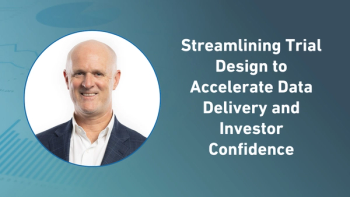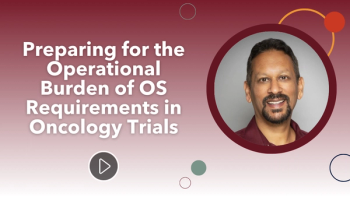
- Applied Clinical Trials-04-01-2013
- Volume 22
- Issue 4
What Does the Future Hold for Clinical Monitoring?
Current commercial forces are working to accelerate the adoption of adaptive monitoring designs.
Related Articles
1.
3.
When you are through changing, you are through." So says Bruce Barton. Bruce who? Think Betty Crocker. She's Barton's creation. So are the enduring household reputations of Campbell Soup, Revlon, General Motors, and General Electric. Barton is among the most successful advertising executives in American history—some insist, the best. A real forward thinker for most of the 20th century.
If Barton were alive today, he would be all over the results of a recent Industry Standard Research (ISR) Study* evaluating what clinical monitoring might look like in 2015.
Why? We know that the biopharma industry is not what it was five years ago as financial pressures continue to mount. Second, we know that clinical monitoring can account for approximately half the costs of later stage clinical development projects, so if companies are going to cut costs, they might as well target the biggest bucket.
That being said, survey results reinforced that traditional clinical monitoring will not go away. It can't. Its scope is a critical component to help ensure squeaky clean data and utmost patient safety. Yet, according to study results, if sponsors and service providers are to relieve stubborn industry-wide financial pressures and meet growing industry demands, clinical monitoring must begin to morph into more of a hybrid model—at least in the later phases of clinical trials. As one respondent aptly put it, "There is a large area of opportunity to improve how clinical trials are conducted. Hopefully the combination of new technologies and alternative models can help to improve monitoring and data quality."
What's in it for sponsors and CROs?
Consider these study results a wake-up call to action. The report details the overall awareness, interest, and likelihood that alternative models would be adopted for clinical monitoring; it exposes the barriers to adopting these models; it outlines appropriate phases of development for the various mix of monitoring models; analyzes the best pricing models for this highly outsourced activity; and broadens the industry's understanding of how the clinical monitoring environment will likely change over the next few years.
Merging industry forces lead to change
While the biopharmaceutical industry can be slow to change, current commercial forces are working to accelerate the adoption of adaptive monitoring designs. These forces (a struggling economy, lack of novel drugs in the pipeline, mega mergers, sub-par financial performance, and the patent cliff) will impact clinical monitoring, just as it has impacted other facets of biopharma.
Many companies saw the handwriting on the wall early on. In the late 1990s, Novella Clinical began to test new monitoring models, utilizing EDC for both data capture and remote review. Today, Novella utilizes a combination of on-site and centralized monitoring to effectively monitor clinical studies. On-site monitoring allows monitors to assess study documentation, compliance with protocol, staff training, and source documentation, while a centralized monitoring team, through its data coordination center (DCC), provides remote data review and coordination.
"By leveraging the two groups we have developed a targeted monitoring approach that increases centralized monitoring with a corresponding decrease in on-site monitoring," explains Novella's Nick Dyer, Executive Vice President of Business Development.
"The targeted monitoring plan is designed by planning to monitor a random sampling of selected patients and/or specific data points. Centralized monitoring through our DCC provides remote data review and coordination in support of the field monitoring staff. By having the DCC review these patients, much of the normal data inconsistencies will be cleaned prior to a monitor ever visiting the site; and through our centralized review, any study data trends are addressed. In addition, the constant review of data coming in through the EDC system improves follow up with sites, which translates into improved data entry metrics and faster query generation and resolution."
As a consequence, the trend Novella is seeing is an increased sponsor comfort with their hybrid centralized/on-site monitoring models, as more organizations are willing to utilize a targeted on-site monitoring model in combination with the centralized data review team.
Not a complete change
Generally, sponsors maintain some monitoring function with internal staff. Yet, according to survey results, the majority of biopharmaceutical companies (92%) rely on outsourcing to support their monitoring functions.
That degree of outsourcing will not change. Sponsors indicated they plan to continue to utilize monitoring support from the same mix of service providers they use today, i.e., CROs, temp and contractor staffing agencies, and BPOs.
In terms of the mix between in-house and outsourced clinical monitors, the mix will shift slightly more in favor of outsourced monitors. The current mix showed roughly 40% to 60% (in-house versus outsourced), and the mix by 2015 will likely be in the 30% to 70% range.
While this is good news for service providers, the question is, how will they differentiate their clinical monitoring services? Based on CRO media, it seems they are already attempting to differentiate themselves by developing newer, non-traditional models in order to offer a more customized approach to clinical monitoring.
Aptiv Solutions, for example, has developed specific technology (AptivAdvantage™) and work processes geared toward adaptive clinical trials. Phil Birch, Corporate Brand Manager for Aptiv, explains the company's differentiation is its technology and execution processes. "Particular emphasis has to be placed on complex adaptive design trials, which provide the highest value information to aid development decision making. Complex design trials will revolutionize drug development."
Premier Research, on the other hand, focuses its efforts on electronic data capture. "We feel that EDC will provide the best scalable solution that is both flexible and automated for a centralized point of tracking, while providing near real-time remote/centralized access to site data and metrics and retain the high quality that is required," notes Patrick Young, Executive Director, Clinical Trial Management and Clinical Monitoring Services.
"We are continuing to review and assess more efficient and effective centralized approaches to clinical monitoring that will improve both time and cost without reducing data quality. Our primary focus will always be the quality of data and ensuring that it does not suffer in the pursuit of efficiency."
Figure 1. Study results indicate that although respondents are substantially less aware of the triggered, on-site model, they are just as interested in it as they are in traditional, regularly scheduled on-site monitoring.
While these newer approaches to clinical monitoring are being utilized by some, how aware of, and interested in, them are sponsors and service providers? As you can see from Figure 1, study results indicate that although respondents are substantially less aware of the triggered, on-site model, they are just as interested in it as they are in traditional, regularly scheduled on-site monitoring.
Moreover, Figure 2 suggests that while most respondents currently use a traditional approach, which is likely to continue through 2015, more significant growth is projected to come from the triggered and remote, centralized approaches—45% and 107% growth respectively.
Figure 2. Utilization of three monitoring models today and in 2015.
Scott Houston, Director, Clinical Operations at Omeros, a Seattle-based biopharmaceutical company, describes his company's use of alternative monitoring models as one that starts with a comprehensive monitoring plan and includes data management and medical review, as well as centralized remote clinical review and cleaning of EDC data. "We anticipate and achieve less CRA hours spent per patient with this additional level of centralized site support and management, without a reduction in total monitoring oversight. Intensive management of site data entry and query resolution provides relief to CRA workload while on-site, and a quick and early avenue for addressing data trends across sites and the study. This is very important in a fast-moving trial. Centralized targeted review of screening data prior to randomization, including inclusion/exclusion criteria, concomitant medication, and medical history, provides the sites an additional and welcome level of support in screening for eligible subjects. The sites have responded to us with very positive feedback."
Figure 3. Quantitative web-based survey of highly screened individuals who have responsibility for clinical monitoring activities within their organization.
Clearly, while there is very solid interest in non-traditional models, study results indicated that not all models are best suited for all development phases.
- There's almost an inverse relationship in Phase I and Phase IV in traditional monitoring, versus triggered and remote hybrid models.
- Phase IV studies are very well suited for non-traditional monitoring models. The industry recognizes that traditional monitoring is very expensive for longer, larger studies, and other options are needed.
- Phase I studies are not currently the place for non-traditional monitoring models to secure their foothold. Given the relatively low number of sites and volunteers/patients, the opportunity for efficiencies may be modest.
- Remote/centralized monitoring becomes a lot more "suitable" in the minds of respondents when it is combined with another model.
- Triggered monitoring (and hybrid triggered-traditional) is viewed as very well suited for Phase IIIb studies.
- Using a mixed model for monitoring is appealing to respondents and is, in fact, viewed as more suitable in some instances.
Dyer agrees there's no one-approach-fits-all methodology: "No single monitoring approach can be used for all clinical trials. A clinical monitoring plan should be tailored to the specific human protection and data integrity risks of the trial and should also focus on the critical data and processes identified by the risk assessment."
Clearly, survey respondents see the need for change and are open to it in the proper context. Because data quality concerns are the biggest barrier to adoption for non-traditional monitoring models, if they are to succeed, they will need to first and foremost ensure data quality does not suffer.
"At Aptiv Solutions," offers Birch, "we have changed the data cleaning process such that study data is continually cleaned and reviewed in stream, and in parallel, by the combined team efforts of the data manager, programer, statistician, and medical (physician) reviewer. This ongoing data review by a physician ensures that the data is medically plausible and in a state that is ready for interim analysis at all times. Our goal is to clean all study data in stream during the trial, and not to simply focus on cleaning the primary data for decision making. This includes the coding of all relevant data as well as undertaking the SAE and external data reconciliations resulting in data that are as clean as possible for making the adaptation decision."
What can sponsors and CROs do to get ahead of the curve?
Sponsors. A short leap of faith is needed. Help service providers put air-tight plans in place when it comes to data quality and patient safety. Increasing the penetration of non-traditional monitoring might end up costing more in terms of both hard dollars and soft oversight dollars (people's time). Look at this as an investment. Sponsors will also need internal advocates who are passionate about these models and who are influential enough to help garner support. Houston adds, "We've achieved significant savings from the classic CRA responsible-for-all-site-activities model by transferring site management, clinical data review/cleaning and data trend response to workers that excel with these specific skills and have a lower cost than CRA's. Both the transfer of these responsibilities to centralized personnel at a lower cost per hour and the greater efficiency of the CRA at the site have reduced our overall monitoring costs significantly."
Service providers. Coming to the table with a lot more trial planning, contingency, and scenario-based strategies for any trial involving a non-traditional monitoring plan is a necessity. Technology platforms and portals must be solid and near real time. From a marketing perspective, CROs must quickly develop named case studies that contain hard metrics. And maybe, most importantly, find some early adopters with whom to partner.
Research showed no difference in respondents' interest in the monitoring models based on their company size. The study had hypothesized that mid-size and smaller companies would be more interested in non-traditional models, but this was not the case. Finally, the models must be cost effective for the sponsors.
What might pricing look like?
While the study examined various preferences for pricing models, (per patient, per site visit, fixed price/lump sum, fixed price per site that enrolls patients, price per CRF page, and hourly rate), respondents held varying views on which are preferred.
Service providers will have options for how they plan to charge for these newer models, however some sponsors are leaning toward models that include a fixed-price component. This opens up the possibility for greater risk-reward contracts, and while those come with the opportunity for more profit, they also come with more volatility that could negatively impact cash flows.
Walk before you run
If the goal is to increase the adoption of more efficient monitoring models, whether because companies want to or need to, the path of least resistance would be to start with a mixed model of part traditional, on-site monitoring alongside triggered or remote/centralized monitoring. Sponsors and service providers, alike, will need to treat any foray into this environment with a lot of extra planning, discussions with regulators, and with a longer-term payback period in mind. There will be challenges, including a perceived lack of confidence in non-traditional models' data quality, system upgrades, re-education—and, of course, cost.
Once these obstacles are hurdled, sponsors and service providers will need to demonstrate to regulators that these hybrid models keep patient safety at the top of the list and data quality is on par with traditional studies. Then adoption will begin to accelerate.
Now is the time to act
There is a high level of interest in these non-traditional monitoring models. In fact, many companies are already utilizing variations of these newer models.
Start discussions with each other and the regulatory bodies to ensure everyone is aligned with the same set of expectations. The successful implementation of these models will pull together technology applications, regulatory experts, novel business models, and clinical operations innovations.
Sponsors and service providers will have to be equal partners in this endeavor if these models are to succeed.
Just as Bruce Barton was able to ensure Betty Crocker endured decade after decade by changing with the times, tweaking clinical monitoring models to realign with the times is vital to the overall health of the biopharma industry.
*This online quantitative research survey polled a total of 81 biopharmaceutical sponsors and service providers. All respondents have responsibility for clinical development activities for their respective companies.
Andrew Schafer is the President of Industry Standard Research, PO Box 1842, Cary, NC, e-mail:
Articles in this issue
over 12 years ago
Act coverover 12 years ago
FDA Promotes Quality and Risk Managementover 12 years ago
Personalized Medicineover 12 years ago
Collaboration Planningover 12 years ago
Standardization in Biospecimen Storage and Researchover 12 years ago
Business and People April 2013over 12 years ago
Act Insert Coverover 12 years ago
The Best-Laid Plans...Newsletter
Stay current in clinical research with Applied Clinical Trials, providing expert insights, regulatory updates, and practical strategies for successful clinical trial design and execution.






.png)



.png)



.png)
.png)
